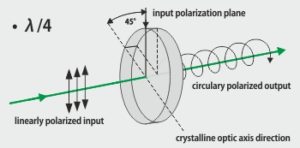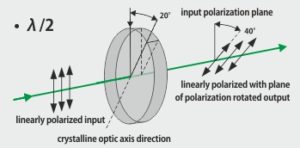General Information
Mica is a naturally occurring birefringent biaxial crystal. It is cleaved into wafers of precisely controlled thickness to produce optical retarders at user-specified wavelengths. Due to its natural cleavage, mica is suitable to produce accurate zero-order retarders at a much lower cost than any other base material. Mica waveplates can be used over a fairly broad wavelength range. For example a 5% change of wavelength results in only 0.6% transmittance of light with incorrect polarisation. The mica sheet is extremely thin so in most cases it is laminated between protective glass plates for easy handling. Antireflection coatings for laminated and bare mica plates enhance transmission. Ring mounts are available as an option for easy system integration.
Absorption / Dispersion / Path difference / Birefringence
Mica is transparent from approximately 350 nm to 6 µm, but not free of absorption.
Mica retarders are zero-order devices and show low dispersion and angular sensitivity and have uniform retardation over the aperture.
The birefringence of Mica is about 0.0054. The retardance of mica (expressed in nm) is nearly independent of wavelength. Consequently a quarter-waveplate for 1064 nm has 266 nm path difference and is also a half waveplate at 532 nm.
Waveplates can be tilted to tune retardation either upwards or downwards, depending on the orientation of the tilt axis.
The effect is nearly quadratic with tilt angle.
A 10° tilt causes about 0.6% change in retardation.
Principle / Application – λ/4 Waveplate
Mica quarter waveplates create a quarter-wavelength phase shift (π/2, 90°) and can convert linear polarization to circular polarization and vice versa. They are often used with a linear polarizer to form an isolator, blocking light reflected back from other surfaces (ellipsometry, optical pumping, isolation).
Principle / Application – λ/2 Waveplate
Mica half waveplates retard one polarization direction by half a wavelength (π, 180°), effectively changing the direction of linear polarization, depending on the orientation of incident linear polarization with respect to the crystal axis. Therefor they can be used as continuously adjustable polarization rotators e.g. in electro optical modulation or as a variable beam splitter when used in combination with a polarizing beam splitter.
Natural Mica Properties: Muscovite
| Property | Unit | min. | typ. | max. |
| General | ||||
| Colour | ruby, green, white | |||
| Crystal Structure | monoclinic | |||
| Cleavage | basal, eminent | |||
| Water of constitution | % | 4,5 | ||
| Moisture absorption | very low | |||
| Maximum operating temperature | °C | 500 | 600 | |
| Mechanical | ||||
| Density | g/cm³ | 2,8 | 3,1 | |
| Hardness – Mohs | 2,0 | 2,5 | ||
| Hardness – Shore Test | 80 | 105 | ||
| Tensile strength (approx) | GPa | 0,17 | ||
| Shear strength | GPa | 0,22 | 0,26 | |
| Compressive strength | GPa | 0,19 | 0,28 | |
| Modulus of elasticity | GPa | 140 | 210 | |
| Thermal | ||||
| Specific Heat | J/(g•K) | 0,88 | ||
| Thermal conductivity (perpendicular to cleavage plane) | W/(m•K) | 0,3 | 0,5 | 0,7 |
| Coefficient of Thermal ExpansionK | K -1 | 9•10-6 | 12•10-6 | |
| Calcining Temperature | °C | 700 | 800 | |
| Melting Point | °C | 700 | 1000 | |
| Electrical | ||||
| Dielectric Constant | 6 | 7 | ||
| Apparent electric strength (RMS @ 15 °C, 25 – 75 µm thickness) | kV/mm | 120 | 200 | |
| Apparent electric strength (RMS @ 15 °C, 250 – 1250 µm thickness) | kV/mm | 40 | 80 | |
| Dielectric Loss (Power Factor) (@ 15 °C) | 1•10-4 | 4•10-4 | ||
| Volume Resistivity | ohm•m | 4•1011 | 1•1013 | 2•1015 |
| Optical | ||||
| Optic axial angle (2V) | degree | 38 | 47 | |
| Orientation of optic plane to symmetry | perpendicular | |||
| Refractive Index nα | 1,552 | 1,576 | ||
| Refractive Index nβ | 1,582 | 1,615 | ||
| Refractive Index nγ | 1,587 | 1,618 | ||
| Maximum Birefringence δ | 0,035 | 0,042 | ||
| Dispersion | r > v, weak |
The original material in this article is taken from the website of S&R Optic GmbH and is used with the permission of Dr. Wolfgang Schneider
For more information, please check out our listings on FindLight or visit our website
About S&R Optic GmbH
We are an independent, privately held company, located north of Frankfurt, Germany. Our team can look back on many years of management and production experience in the most reputable companies in the crystal optics industry. S & R Optic has quickly established itself as a leader in optical waveplates / components from its advanced technology and quality control. |
Our projects and products can be found in areas of:
- Metrology and medical technology
- Imaging systems
- Detection schemes
- Analytical instruments
- Microscopes
- Laser technology
- Interferometry
- Semiconductor technology
- Research & Development


